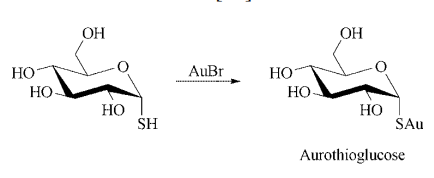(α-D-Glucopyranosylthio)gold Chemische Eigenschaften,Einsatz,Produktion Methoden
R-S?tze Betriebsanweisung:
R42/43:Sensibilisierung durch Einatmen und Hautkontakt m?glich.
S-S?tze Betriebsanweisung:
S22:Staub nicht einatmen.
S36/37:Bei der Arbeit geeignete Schutzhandschuhe und Schutzkleidung tragen.
S45:Bei Unfall oder Unwohlsein sofort Arzt zuziehen (wenn m?glich, dieses Etikett vorzeigen).
Beschreibung
Aurothioglucose is highly water soluble, and its aqueous solutions decompose on long standing. It therefore is
available as a suspension in sesame oil. Gold content is approximately 50%. Following IM injection, it is highly
protein bound (95%), and peak plasma levels are achieved within 2 to 6 hours. Following a single 50-mg dose, the
biological half-life ranges from 3 to 27 days, but following successive weekly doses, the half-life increases to 14 to
40 days after the third dose. The therapeutic effect does not correlate with serum plasma gold levels but appears to
depend on total accumulated gold. Aurothioglucose is indicated for the adjunctive treatment of adult and juvenile
rheumatoid arthritis.
Chemische Eigenschaften
yellow crystals,
History
In 1927, aurothioglucose was found to relieve joint pain when used to treat bacterial endocarditis. The area of chrysotherapy had begun. Subsequent investigations led to an extensive study of gold compounds in Great Britain by the Empire Rheumatism Council, which reported in 1961 that sodium aurothiomalate was effective in slowing the development of progressive joint diseases. Both aurothioglucose and sodium aurothiomalate are orally ineffective and are administered by IM injection. In 1985, the first orally effective gold compound for arthritis, auranofin, was introduced in the United States. Several other gold compounds have been evaluated clinically but do not appear to offer advantages in terms of efficacy or toxicity.
Verwenden
Aurothioglucose hydrate has been used in redox stress survival assay in human cell lines and for inducing obese phenotype in mice.
Clinical Use
Aurothioglucose is highly water soluble, and its aqueous solutions decompose on long standing. It therefore is available as a suspension in sesame oil. Gold content is approximately 50%. Following IM injection, it is highly protein bound (95%), and peak plasma levels are achieved within 2 to 6 hours. Following a single 50-mg dose, the biological half-life ranges from 3 to 27 days, but following successive weekly doses, the half-life increases to 14 to 40 days after the third dose. The therapeutic effect does not correlate with serum plasma gold levels but appears to depend on total accumulated gold. Aurothioglucose is indicated for the adjunctive treatment of adult and juvenile rheumatoid arthritis.
Sicherheitsprofil
Confirmed carcinogen
with experimental carcinogenic and
neoplastigenic data. A deadly human poison
by an unspecified route. An experimental
poison by intramuscular route. Moderately
toxic by subcutaneous and intravenous
routes. Human systemic effects: nausea or
vomiting, cholestatic jaundlce, and eye
effects. An experimental teratogen. Other
experimental reproductive effects. See also
GOLD COMPOUNDS. When heated to
decomposition it emits very toxic fumes of
SOx. Used to treat rheumatoid arthritis.
Synthese
Synthesis: gold thioglucose is prepared by
adding a solution of gold bromide to an aqueous
solution of thioglucose that contains sulfur dioxide. After heating, the product is precipitated by
the addition of ethanol.

l?uterung methode
Purify it by dissolving it in H2O (0.05g in 1mL) and precipitating it by adding EtOH. It yields yellow crystals with a slight mercaptan odour. It decomposes slowly in H2O, and is soluble in propylene glycol but insoluble in EtOH and other common organic solvents. [Caterson & Taylor FEBS Lett 98 351 1979, Cooney et al. Biochem J 259 651 1989.]
(α-D-Glucopyranosylthio)gold Upstream-Materialien And Downstream Produkte
Upstream-Materialien
Downstream Produkte

